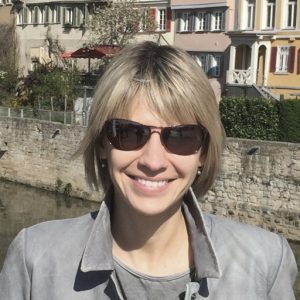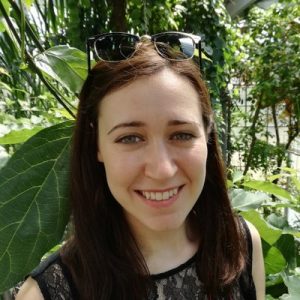The Society’s Distinguished Lecturers for 2024–25 have been selected. They are Casey Bryce (University of Bristol) and Frances Cooper (University College London).
Here are the programmes for our Distinguished Lecturers for 2024-2025
Frances Cooper
- Manchester: 11th November 2024 (lecture C)
- Bayreuth, Germany: 28th November 2024 (Lecture C)
- Galway: 12th February 2025 (lecture D)
- Camborne School of Mines: 5th March 2025 ()
- Bristol: 23rd April 2025 (lecture C)
- Cardiff: 6th May 2025 (lecture D)
- Cambridge: 3rd June 2025 (lecture C)
Casey Bryce
- UCL/Birkbeck: 8th November 2024 (lecture A)
- Glasgow: 15th November 2024
- Trinity College Dublin: 31st January 2025 (lecture B)
- Oxford: 7th March 2025 (lecture A)
Distinguished Lecturers 2024–25


Frances Cooper, University College London, UK Casey Bryce, University of Bristol, UK
Casey Bryce
Lecture A: Microbial iron oxidation across the Great Oxidation Event and beyond
Phototrophic Fe(II)-oxidizing bacteria, or “photoferrotrophs”, were probably a key driver of primary productivity and Fe(III) mineral formation in the Earth’s oceans prior to the rise of oxygen. As O2 began to rise and oxygenate the photic zone, these anaerobic microbes would have seen their habitable space decrease. Furthermore, the transformation from an anoxic to an oxic world would have facilitated an increase in the concentration of oxidized nitrogen species such as nitrate in the oceans. Nitrate-dependent oxidation of Fe(II) is widespread in modern anoxic environments and could, in theory, have competed with photoferrotrophs for Fe(II) in regions where nitrate, light and low-O2 conditions still co-existed. However, the competition dynamics between these different types of anaerobic Fe(II) oxidation are not well constrained.
Utilizing various co-culture experiments, we have shown that Fe(II) oxidation by photoferrotrophs is not only out-competed but completely inhibited by the activity of nitrate-dependent Fe(II)-oxidizing bacteria. We primarily attribute this inhibition to the observed accumulation of nitric oxide (NO) during denitrification, which is highly toxic at low nanomolar concentrations. These results suggest that the evolution of the nitrogen cycle over the Great Oxidation Event could represent a yet unreported control on the extent of Fe(III) mineral formation by photoferrotrophs in the ancient oceans.
Lecture B: Iron-rich peatlands in a warming world
Peatlands in the northern hemisphere store vast quantities of Earth’s soil carbon, largely thanks to the cold and wet climate which limits decomposition of organic matter. However, these fragile wetland systems are rapidly changing in response to warming temperatures, changing precipitation patterns, permafrost thaw, and drainage for agriculture or mining. All of which act to make peatlands either drier or wetter. In turn altering carbon storage and greenhouse gas emissions. To understand the future fate of Earth’s terrestrial carbon stores, we must understand how peatlands will respond to these stressors.
However, not all peatlands are the same. Local variations in hydrology, geology and geochemistry can make the degradation of some peatlands complex to predict and challenging to mitigate. For example, in areas rich in iron, enhanced waterlogging (such as is promoted by permafrost thaw) can release large quantities of previously mineral-associated carbon. On the other hand, drainage of iron-rich peatlands can release sulfuric acid, iron and toxic metals which make them complicated to restore. Using a combination of insights from mineralogy, geochemistry and microbiology at peatlands across the northern hemisphere; I will discuss the role of iron in shaping peatland degradation responses and the strategies needed to protect iron-rich peatlands in the future.
Frances Cooper
Lecture C: How crustal exhumation rates determine the fate of porphyry copper deposits
Copper is an essential component in most clean energy technologies and fundamental to the success of the global green energy transition. It is mainly sourced from porphyry copper deposits (PCDs), which are metal-rich magmatic-hydrothermal systems typically associated with subduction zones. However, PCDs are rare and proving increasingly difficult to find. They are also high tonnage (~100–1,000 Mt) and low concentration (average production grade is ~0.53% Cu), so enormous volumes of rock must be extracted to retrieve tiny amounts of metal. As the global demand for copper surges to meet ambitious green energy targets, society is confronted with the dual challenge of locating increasingly elusive PCDs while prioritising those with the lowest potential environmental impact. This means finding the most copper-rich (highest-grade) deposits, which require the smallest amount of extraction and processing, and thus create the least damage to the environment.
The exhumation history of a PCD plays an important role in determining its copper grade. During the initial “hypogene” stage of mineralisation, rapid exhumation is required to advect heat towards the surface, allowing metal-carrying magmas and fluids to transport their cargo into the shallow crust. To maximise ore grades, exhumation must then slow considerably so the deposit can linger close to the surface where secondary “supergene” enrichment by oxygenated groundwater water takes place. In this talk, I will present an example from the Eocene-Oligocene copper belt in northern Chile, which is the world’s premier PCD province, but disappears to the north as it approaches the Peruvian border. By combining U-Pb zircon geochronology, Al-in-hornblende geobarometry, low-temperature (U-Th-Sm)/He thermochronology, and thermal-kinematic modelling to track exhumation histories, I will show that (1) both the rate and timing of exhumation are critical in determining the potential of an area to host high-grade PCDs; and (2) northward disappearance of the copper belt close to Peru is due to higher exhumation rates in that area, which prevented supergene enrichment and potentially led to loss of deposits via surface erosion.
Lecture D: Tracking groundwater flow in the hyperarid Central Andes: Insights from copper enrichment
The Atacama Desert on the western margin of the Central Andes has the dual honour of being one of the driest places on Earth and host to the richest porphyry copper province in the world, accounting for 24% of global copper production. This high concentration of copper is partly due to secondary “supergene” enrichment of many of the deposits, driven by leaching and reprecipitation of copper by oxygenated groundwater during surface weathering. However, the Atacama has been dry since at least the middle Miocene, so how and when did this enrichment take place?
In this talk, I will discuss how the age and composition of hematite left behind by the leaching process can tell us about the history of surface weathering and the sources of the fluids driving enrichment. I will focus on two deposits in northern Chile – Spence and Cerro Colorado – both of which have experienced significant supergene enrichment, but under quite different circumstances. By combining (U-Th-Sm)/He geochronology with δ18O isotopic analysis of hematite in the leached zones of both deposits, I conclude that: (1) continuous hematite precipitation at Cerro Colorado since ~31 Ma reflects a protracted period of weathering, and captures progressive lowering of the water table driven by aridity-induced canyon incision in the late Miocene (~11 Ma); and (2) hematite at Spence precipitated later (≲10.5 Ma) when the climate was already dry, and has a heavy δ18O signature suggesting that weathering was not driven by in-situ precipitation, but from groundwater sourced far away in the high Andes. This means that direct precipitation is not required to drive weathering (and thus supergene enrichment), which can continue at depth beneath appreciable cover even in a hyperarid climate.
Download this form if your (UK/Ireland) department would like to host one of our lecturers.